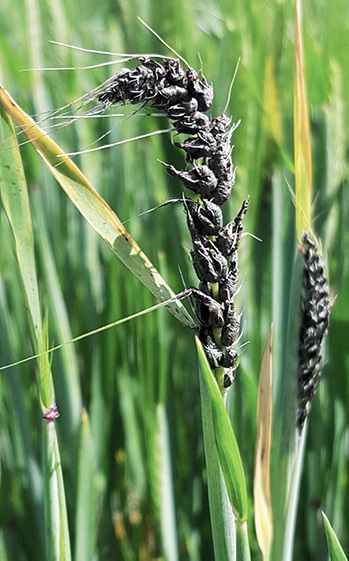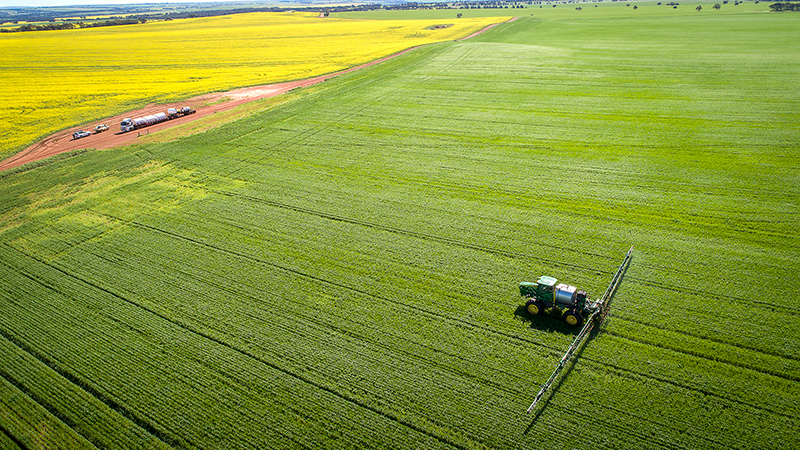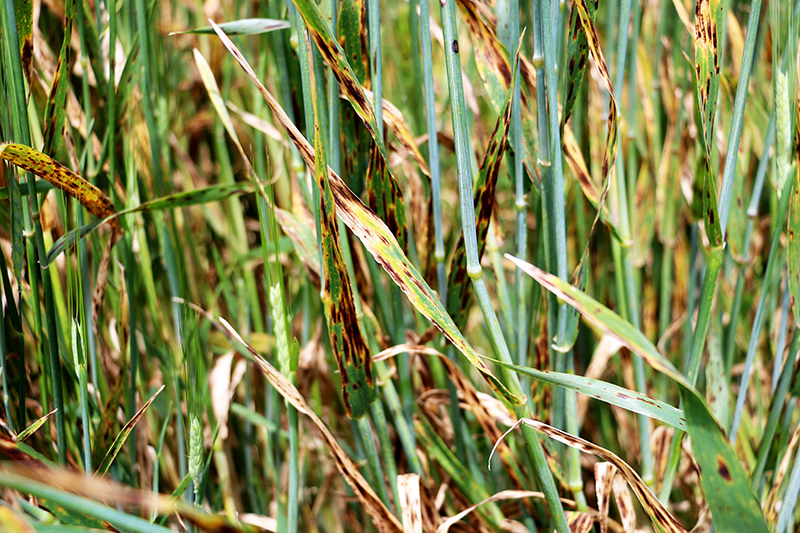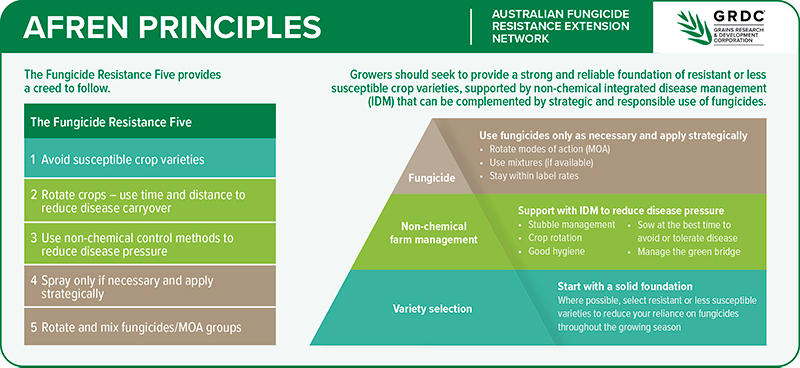Paddock Practices: Start managing 2025 disease risks now
Paddock Practices: Start managing 2025 disease risks now
Date: 08 Nov 2024

Key points
- Warm conditions and variable rainfall across Western Australia have contributed to mixed levels of fungal disease severity this season.
- One of the key ways to reduce disease pressure in cropping paddocks is to limit disease carry-over between seasons.
- When selecting crop varieties for 2025, review the fungal diseases that were most common in your paddocks and region in 2024. Consider the risk of these diseases surviving and infecting next year's crops.
- Take the time to consider your hygiene practices and seed treatments, as these can greatly affect disease management and the overall health of your crops next season.
- An integrated disease management strategy that leverages a year-round approach will reduce disease pressure and enhance the reliability of fungicides when they are applied.
Warm conditions across much of WA and variable rainfall have contributed to mixed levels of fungal disease severity in the state’s cereal, pulse and oilseed crops during 2024.
Smuts have been prevalent in barley (loose smut), wheat (flag smut) and oats (loose smut). Leaf rust has been detected in some wheat varieties, but infection rates have been relatively low and easily managed. Crown or leaf rust of oats has been found in susceptible oat varieties in the Kwinana and Albany port zones, while oat stem rust was also detected at Wickepin and Highbury.
Barley scald has appeared in some high and low-rainfall zones, while an aggressive strain of net form net blotch (NFNB) continues to persist in RGT Planet crops in the Albany port zone. This strain is also present in some varieties closely related to RGT Planet, such as Atlantis and Zena, across barley production areas.
Powdery mildew, yellow spot and septoria nodorum blotch (SNB) as mixed infection were all reported in wheat crops from early September.
Sclerotinia canopy infection has affected pulse, lupin and canola crops, particularly in the Geraldton and Kwinana north port zones, while basal sclerotinia infection has been problematic in lupin crops in these regions and some lupin crops in the Albany port zone.
With these factors in mind, plant pathologists from the Department of Primary Industries and Regional Development (DPIRD) are urging growers to start planning now so the risk of disease carry-over into 2025 is minimised.

Avoid disease carry-over into 2025
One of the key ways to reduce disease pressure (and fungicide requirements) in cropping paddocks is to limit disease carry-over between seasons. Many of the diseases seen in the west this season have the potential to re-infect next year’s crops if the conditions are favourable and precautions are not taken.
Fungal diseases generally survive the summer fallow by persisting on stubble, in soil in the case of some smuts and sclerotia, or by infecting a range of ‘green bridge’ hosts and spreading their wind-borne spores far and wide early in the growing season.
To mitigate these disease sources, it is vital to practice regular crop rotations and avoid planting the same crop into the previous season’s stubble. This can be difficult in regions where rotation options are more limited, such as the eastern wheatbelt where barley is often cropped continuously.
Selecting cultivars for genetic resistance to key diseases should be seen as essential in these systems.
Susceptible varieties encourage disease build-up
The risk of crop diseases recurring across subsequent seasons is greatly increased by repeated planting of cultivars that are rated very susceptible or susceptible (VS, S) to prevalent pathogens.
Avoiding varieties that are very susceptible (VS)/susceptible (S) to prevalent diseases can help to lower the disease pressure from season to season. For example, DPIRD spot-form net blotch (SFNB) research in the low rainfall zone of WA has shown that stubble-borne inoculum levels are lower after selecting and growing varieties with better disease resistance.
Conversely, crops with low genetic disease resistance are likely to suffer higher rates of infection, leave more disease inoculum in the paddock, and support a rapid build-up of the same disease in the following season. This is a pattern evident with net form net blotch (NFNB) on RGT Planet in Esperance and Albany port zones.
Even if yield is not impacted in the short term, the elevated rates of infection require higher concentrations and frequency of fungicide applications to provide adequate control. Under conducive weather conditions, a high starting rate of disease can overwhelm the available fungicide options, even at maximum label rates.
Furthermore, high rates of disease and more frequent fungicide use can both accelerate the development of reduced sensitivity or resistance to fungicides, with serious long-term implications for future production.

Use variety selection to support disease management
When selecting crop varieties for 2025, growers should review the fungal diseases that have dominated their paddocks and region in the 2024 season and consider the risk of those pathogens surviving to infect next year’s crops.
For example, some newer barley varieties may have weak resistance to barley scald, despite being rated as moderately resistant (MR) to resistant (R) to more common diseases. Overlooking this susceptibility could make it easy for scalds to increase in areas where the disease has been a developing problem this year.
Where pressure from a particular disease is high, there is evidence that planting more resistant cultivars and accepting a slight reduction in yield potential can deliver greater economic benefit than spending extra on fungicides to try and control the disease in more susceptible varieties.
Varietal resistance should be supported by applying Integrated Disease Management practices (IDM) such as crop rotations, stubble management, farm hygiene practices, and effective green bridge removal. It is worth noting that green bridge plants often host a range of insect pests, including virus carriers such as aphids, so control of these plants can provide multiple benefits.
WA Crop Sowing Guide
Understanding the disease resistance ratings of different varieties will help growers make the best variety choices for their conditions and plan their integrated disease management (IDM) approaches to address known disease risks.
For the latest information on crop varieties and disease resistance ratings, refer to the 2025 WA Crop Sowing Guide, which is prepared by DPIRD with reference to the latest National Varietal Trial (NVT) data and is due for release this month.
Use the above link to view and download a PDF copy of the Guide, or to request a printed copy from DPIRD. Hard copies will also be available in DPIRD offices.
Use a seed dressing
Several crop diseases that have been common in WA during the 2024 season – including cereal smuts and barley scald – can be carried on infected seed. It is therefore imperative to ensure a registered seed dressing is applied for the disease of concern when sourcing seed for planting in 2025, including when ordering seed for new varieties.
This will help ensure those diseases are not re-introduced into the system for another season and is especially important for controlling loose smut on barley.
Growers with concerns about loose smut should consider applying a SDHI (Group 7) seed dressing, which DPIRD research has shown is the most effective of the registered groups.
Registered fungicide seed dressings can also provide protection against pathogens already present in the paddock, such as soil borne flag smut of wheat, stubble borne net blotch, scald of barley or soil borne root pathogens such as rhizoctonia bare patch.

Extra considerations for canola seed orders
A seed treatment should also be included when ordering canola seed. In areas of low to moderate risk of blackleg (usually in lower rainfall zones, or where canola is not grown as frequently), a seed dressing alone should be adequate. In high rainfall areas, DPIRD pathologists recommend using the BlacklegCM app to assess whether investing in a flutriafol seeding application or 4 leaf spray will be a cost-effective precaution.
Next year will see the release of some promising hybrid canola varieties that offer a combination of resistance traits from more than one major resistance group. These often include Group H, which continues to provide good blackleg control in WA and offers protection from both cankers and upper canopy infection (UCI).
The latest Blackleg Management Guide includes details of available cultivars and their major gene resistance, along with practical steps for practising integrated disease management in canola.
Include seed dressing in fungicide management plans
It is important to note the fungicide mode of action (MoA) used in any seed dressing or in-furrow products used at seeding, and then choose a different MoA or mixture for the first post-emergent spray. This will avoid a repeat application of the same group, as this could encourage fungicide resistance in the paddock.
Fungicides should continue to be rotated and mixed throughout the growing season.
For more information and guidance on planning fungicide rotations, refer to the Australian Fungicide Resistance Extension Network (AFREN) publication Fungicide Resistance Management in Australian Grain Crops.
Count on the AFREN five
While fungicides can provide effective disease control in all crops, they should not be relied upon by themselves.
An IDM strategy that leverages a year-round approach and the full range of agronomic disease counter measures will reduce disease pressure and enhance the reliability of fungicides when they are applied.
Fungicide resistance is a very real, immediate and growing threat to Australian cropping.
Reducing the need for seasonal fungicide applications reduces the risk of a fungal pathogen evolving reduced sensitivity or resistance to fungicides due to over-exposure.
The ‘AFREN five’ is a set of principles that build up a layered approach to disease control, starting with variety selection as a strong foundation and building up to fungicide applications as a ‘last line of defence’.
Following these integrated disease management principles will provide a range of benefits, from lowering yield losses and fungicide costs to simplifying fungicide management and rotation within and across growing seasons.

Useful resources
- DPIRD Western Australia Crop Sowing Guide
- Australian Fungicide Resistance Extension Network (AFREN) – Resources and contacts for fungicide use, fungicide resistance risks and disease management
- PestFacts WA newsletters
- PestFacts WA Reporter app
- GRDC Blackleg Management Guide
- BlacklegCM app
Further reading
- GRDC Groundcover Co-innovation to curb barley blotches (July-August 2022)
- GRDC Groundcover Net blotch fungicide resistance profiling enriches knowledge base (July-August 2022)
- Australian Fungicide Resistance Extension Network (AFREN) Fungicide Resistance Management in Australian Grain Crops
This Paddock Practices article was produced by Grains Research and Development Corporation (GRDC) with input from the Centre for Crop and Disease Management (CCDM) and the Department of Primary Industries and Regional Development (DPIRD) Western Australia.
GRDC Project Code: DAW2404-005RTX, DAW2104-001RTX, DAW2104-002RTX,
